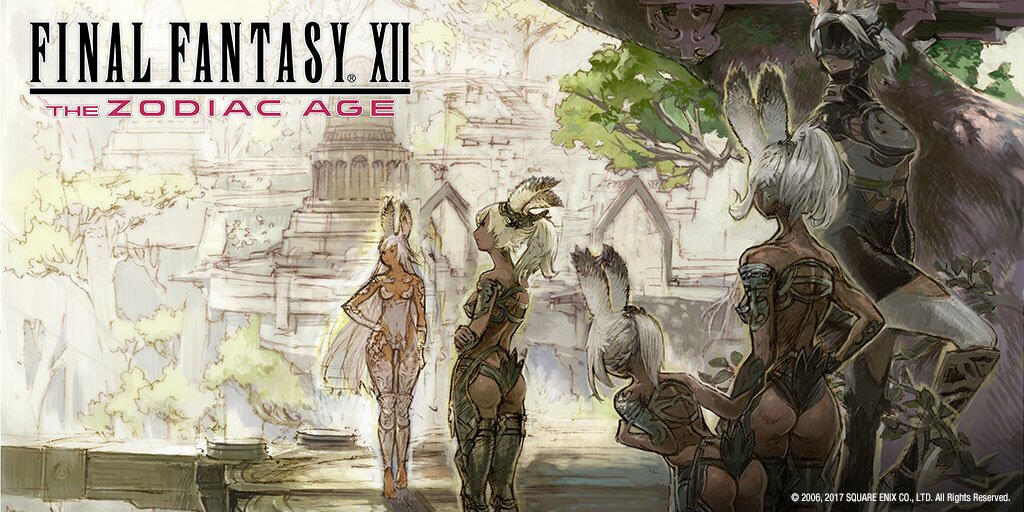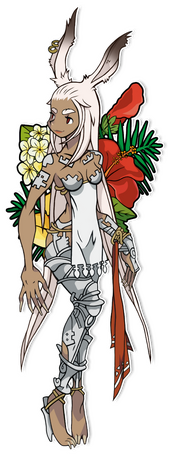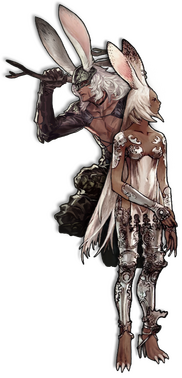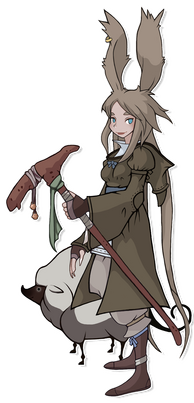
the great hare Adventures
The Vieras
General Informations:
The Vieras live very long lives, more than 360 years old and maybe even way more than that (Spoiler MSQ Shadowbringer: In the shadowbringer questline the Viis ask their sister if she recognizes the seal, hinting that she might have seen it before but it was also known that the seal has been lost for a very long time, since the fall of that civilization long before the flood. Showing that the viis live very long lives and do not age) . The younglings (kit) are of an undetermined sex until their 13th nameday (+-2 years depending on the kit development). 80% of the kit are females and the males are taken by the older males to be instructed in their way. The male vieras come back every 3 to 4 years in their villages to get the new boys but also to mate.The vieras are very sensitive due to their good eyesight and their hearing. Which proves handy when hunted, or hunting. They are also sensitive to the aether, or "Mist" how they call it. When in areas with a lot of Aether they tend to enter a frenzy leading to a loss of control and possible murderous attempts (See Fran in FFXII). The frenzy can be played on different manners and can be seen as some blind rage that boosts the viera's combativity but in their madness loose sense of who are their allies and can end up hurting comrades.The vieras follow the "Green Word", or "Word of the Forest" which is cited by some sources as a set of rules while other sources list it as the will/voice of the forest. The vieras that leave the forest may never return and do not "hear" the Green Word again, except if they were forcefully removed from there. Which can lead to the conclusion that those who leave "cut" themselves from their culture. That can be probably seen by those who adopt a "City name" or "Civilized one".
There is not much known about the viera's jobs, but based on some sources they are good at summoning and some of them take the role of Wood-Wardens (see FFXII, sources from XIV aren't found in-game fanbase forums say that only males are wood-wardens) or Salve-maker. The Salve Makers from Eryut (FFXII and FFXIV) have to follow a rite of passage where they have to catch the vorpal bunny and make vision dust to keep their village hidden. This hunt-rite is surely an important thing for the vieras and we will probably do a few of them. Wood-wardens are not known to ask questions before shooting, or even give a warning.Spoiler MSQ Shadowbringer: Vieras are rarely outpaced as seen in the MSQ when talking about Ran'jit who has done that feat. But it can also be seen in the first meeting of the Warrior of Light and the Vieras:
Naming ConventionsForenames
The Rava and Veena clans share many traditions, naming practices among them. Thus, a Viera’s forename is not indicative of the clan to which they belong─rather, it is the lifestyle they lead that determines whether they bear a “forest” or “city” forename.Traditional Viera forenames given at birth are also referred to as “forest names,” as they are used by those Viera still residing in their homeland─which is the Golmore Jungle, in the case of the Rava, or the forest skirting the Skatay Range for the Veena. Forest names resemble real-world Scandinavian names and are pronounced similarly─in the names “Theja,” and “Nojra,” for instance, the “j” sounds more like an English “i.”Because a Viera’s male or female characteristics are not present at birth, parents typically opt to bestow their children with names that are considered appropriate for any sex and gender. Nevertheless, in line with the cultural tradition of adopting a new name to suit one’s newfound environment or identity, many Viera choose to change their names upon reaching adulthood. Though in many cases male Viera will choose a traditionally “masculine” name, or female Viera a traditionally “feminine” one, there are myriad examples of Viera who eschew these patterns by keeping or choosing names that are culturally recognized as non-binary or associated with a different gender. For this reason, it is nearly impossible to determine whether a Viera is male or female by forename alone.Furthermore, in keeping with the aforementioned tradition, the majority of Viera who choose to leave their homes and strike out into the wider world also adopt new “city names” to mark their parting from the traditional Viera way of life. These names are often inspired by the names of other races they encounter, or simply things that they like, such as “Cherry” or “Morning Glory,” and so vary widely between individuals. Incidentally, “Fran” is one such name.
Forest names include:
Ruuj, Shara, Rena, Rael, Bjonse, Arjm, Coeli, Ysera, Yurhee, Venase, Ukina, Sonja, Slejsa, Qestra and Petra.Surnames
In the Viera’s forest homeland, surnames are taken from the name of the village of one’s birth. As many female Viera remain in the same forest that they were born, they tend to keep their childhood surnames throughout their lives. However, as with forenames, surnames are generally discarded or replaced once one chooses to venture into the wider world, as a means of symbolizing the severing of ties with one’s homeland. Thus, the majority of female Viera abroad, as well as most male Viera, do not make use of their original surnames.Though female Viera may choose their new surnames, male Viera typically take the same surname as the elder male under whom they train upon first departing their village for the wider forest. The conventions for such surnames vary by clan, but in all cases mark their bearers as noble guardians of the wood.
Rava surnames include:
Hyskaris, Eryut, Camoa, Muscadet, Atoel, Bysnoe, Dei-Ijla, Fyth, Golmarr and IryutVeena surnames include:
Lesrekta, Arda, Ymir, Bosco, Gucuma, Kisne, Tehp, Paharo and Muruc.Male-specific Rava Surnames:
Male Rava inhabit the forest surrounding the village in which female members of their clan reside, forming a sort of perimeter in defense of both the wood and its people. They believe that their purpose is to maintain the natural balance of the six elements in their dual polarities─to ensure harmony between the twelve aspects that comprise our star and the heavens above.In accordance with this philosophy, each Rava surname begins with a syllable to represent either the celestial realm (Djt) or the worldly realm (Rehw), followed by a word that represents one elemental aspect within it. It is believed that those sharing a realm or an element possess a bond that grants them insight into one another’s minds, and as such are wont to join forces when the need for collaboration arises. Further rumors suggest that the Rava consider it necessary that all twelve different surnames be present among the Wood-warders’ ranks at any given time to ensure the forest’s safety and, should any be unaccounted for, will rename a member with a close affinity to said surname to fill the open spot.Male Rava surnames include:
Rehw-Nong (“Frost” – worldly ice)
Djt-Nong (“Moon” – heavenly ice)
Rehw-Marouc (“Spring” – worldly water)
Djt-Marouc (“Star” – heavenly water)
Rehw-Bidit (“Treetop” – worldly wind)
Djt-Bidit (“Tempest” – heavenly wind)
Rehw-Dvre (“Arrow” – worldly lightning)
Djt-Dvre (“Thunderstrike” – heavenly lightning)
Rehw-Gilda (“Sword” – worldly fire)
Djt-Gilda (“Brush Fire” – heavenly fire)
Rehw-Setlas (“Fertile Soil” – worldly earth)
Djt-Setlas (“Cliff” – heavenly earth)Male-specific Veena Surnames
In the mountainous region inhabited by the Veena, villages are frequently enveloped by heavy snows. A male Veena’s surname marks him an integral, albeit small, part of this landscape, combining references to snow crystals with the word “wesfv”─“guardian.” However, as the snowflake-based themes employed and the number of surnames in use differ from village to village, the examples below should be considered only a small sampling of the possibilities.Unlike the Rava, the Veena are not known to regard their Wood-warders as sharing any particular affinities or bonds due to their surnames.Male Veena surnames include:
Sjadarwesfv (“Needle”)
Jgnewesfv (“Sheath”)
Monnawesfv (“Prism”)
Huorlwesfv (“Shield” – referring to what naturalists term “plates”)
Ornedwesfv (“Fan” – referring to “sectored” plates)
Qufiswesfv (“Bullet”)
Foixewesfv (“Spear”)
Ubmuawesfv (“Wand” – referring to gohei twins)
Copihwesfv (“Branch” – referring to dendrites)
Rawbewesfv (“Bone” – referring to hollow crystals)
Phiitehwesfv (“Seagull”)
Gahjewesfv (“Rime”)
Roleplay adaptations for the Tribe
I have done a small thing that we can use/test to see how the viera can react on different areas or based on weather conditions.
| Aether Levels | Effect | Very Weak Viera | Weak Viera | Healthy Viera | Strong Viera | Very Strong Viera |
|---|---|---|---|---|---|---|
| High Aether | Discomfort | 350-450 | 450-550 | 550-650 | 650-750 | 750-850 |
| High Aether | Frenzy | 451-1000 | 551-1000 | 651-1000 | 751-1000 | 851-1000 |
| Very High Aether | Discomfort | 250-350 | 350-450 | 450-550 | 550-650 | 650-750 |
| Very High Aether | Frenzy | 351-1000 | 451-1000 | 551-1000 | 651-1000 | 751-1000 |
You see what is the condition of your viera (most of them should be healthy) and the DM rolls the dice once and based on this chart it is how your char can react.With high Aether locations being: Dzmael Darkhold, Mor Dhona, The Burning Wall, Pharos Sirius, Floating City of Nym, Sea of Clouds, Churning mists, Bozjan Southern Front, Northern Thanalan, Urth Fount, Adampor, Cartenau Flats, Binding Coil, Field of Glory and Moonrise (Steppe).The very High Aether is bound to some weather conditions like Gloom, Umbral Static, Umbral Wind, Quick Levin, Royal Levin and Tension.Communication in the FC: While other FCs use Linkshell pearls, the vieras taught by the Jokullbaer members use the Kulning to allow communication at great distances as their technology is not advanced enough for the linkpearls. The FC can be found that way (RP Hook).
Character Creation:


